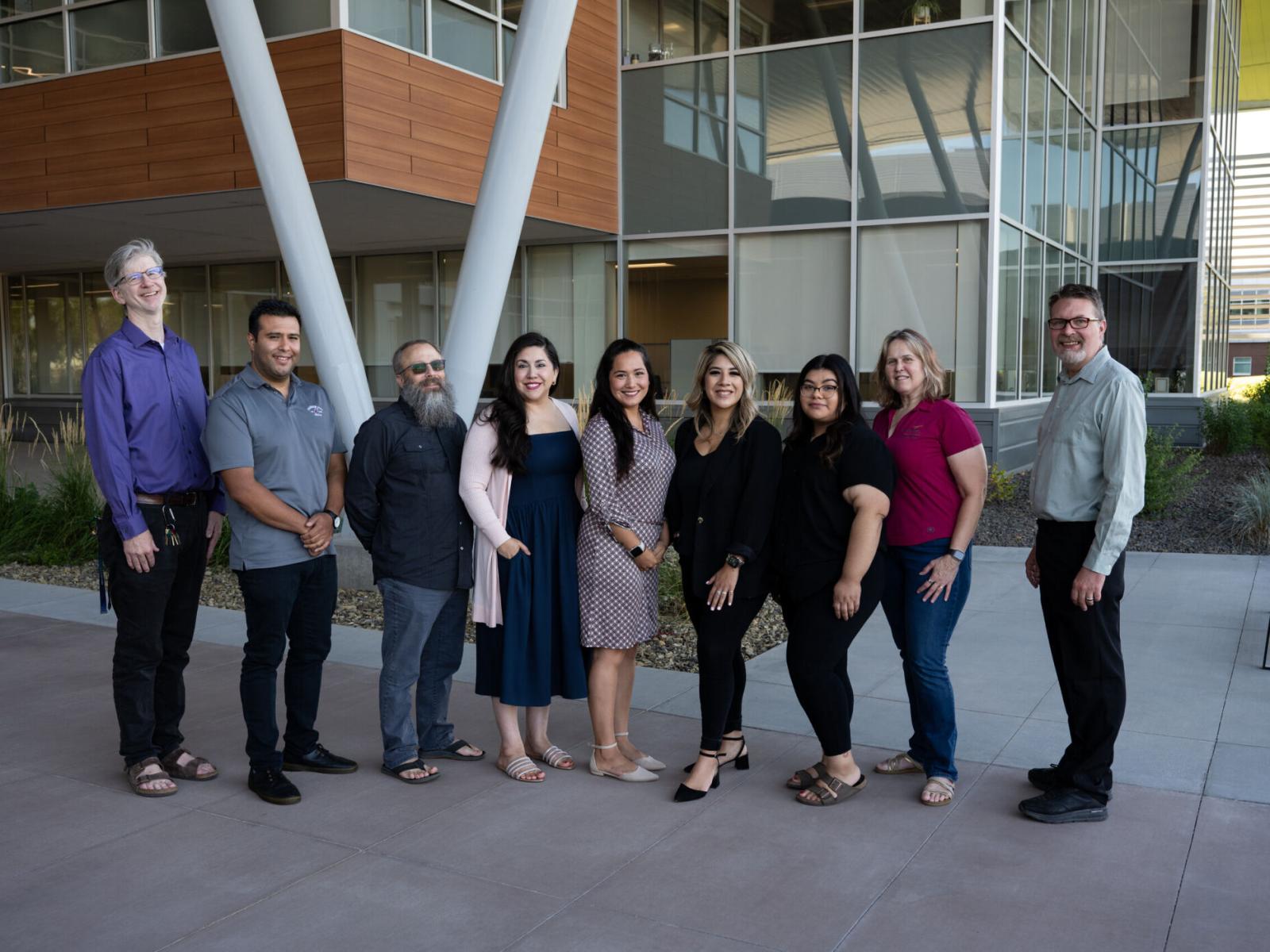Partnering with Educators to Inspire the Next STEM Generation
Pasco School District educators join Pacific Northwest National Laboratory for an immersive teaching experience

The STEM Institute cohort. Left to right – John Weisenfeld (Pasco High School), Jose Garcia (Pasco High School), Jeff Albertsen (Chiawana High School), Elizabeth Stephens (Pacific Northwest National Laboratory), Margarita Magaña (Pacific Northwest National Laboratory), Laura Delgado Bahena (Stevens Middle School), Elizabeth Rios-Morales (Stevens Middle School), Ann Wright-Mockler (Pacific Northwest National Laboratory), Jason Fitzgerald (Pasco High School/Chiawana High School)
(Photo by Andrea Starr | Pacific Northwest National Laboratory)
Pacific Northwest National Laboratory (PNNL) partnered with six middle school and high school educators in the Pasco School District to coach curious minds about Computational and Mathematical Sciences (CMS). This effort was through the Pathway Summer STEM Institute for K-12 Educators (STEM Institute), sponsored by the Office of Workforce Development for Teachers and Scientists (WDTS) and is part of the Reaching a New Energy Sciences Workforce initiative.
The STEM Institute was designed as an immersive, four-week program created to address the workforce gap for STEM careers and to expand networks for educators who work with underrepresented and underserved students to world-class science and technology expertise, facilities, and resources at PNNL and other Department of Energy (DOE) national laboratories.
Lessons from a national laboratory
The ultimate goal of the STEM Institute was to provide CMS connections and innovation that educators could bring back to their classrooms and share with their students. Throughout the four weeks, educators learned about the contributions and efforts of DOE and WDTS to CMS research. The educators discussed ways to incorporate important foundational concepts, such as linear algebra, graph theory, and computational thinking, into their classes and also how they could bring more awareness to internships and career pathways in computational and mathematical sciences with DOE national laboratories.
“We were able to brainstorm how we can move the needle on improving STEM education and STEM career awareness for our students,” said John Weisenfeld, a Pasco High School teacher.
The educators were also introduced to CMS careers in cybersecurity, artificial intelligence, high-performance computing, data analytics, and quantum information sciences. Over the course of the STEM Institute, PNNL researchers engaged the educators in hands-on activities, tours, and laboratory visits that facilitated understanding of research interests and career pathways.
Developing pathways for students from diverse backgrounds to enter STEM is a key priority of the STEM Institute. Throughout the program, participants were able to hear from students and early career researchers as they shared perspectives about the importance of STEM opportunities in their lives and some of the barriers they have faced.
“The number one sentiment that kept coming up was that many of them felt ‘dumb’ at one or many points of their careers,” said Elizabeth Rios, a Stevens Middle School teacher. “Our students are afraid of pursuing STEM careers because they think they are not smart enough, so to hear from scientists and engineers that they have felt that way too is really impactful and something we need to have conversations about with our students.”
During the STEM Institute, the educators engaged in conversations with a variety of PNNL leaders and staff about diversity, equity, inclusion, and accessibility challenges in STEM institutions and how to overcome them.
“The session that still echoes in my ears and heart are the times that we spoke with interns and early career scientists closest in age and experience to our students,” said Weisenfeld. “Their observations and insights challenged me, humbled me, and sometimes moved me very deeply.”
Transitioning lessons from the laboratory to the classroom
As an outcome of the experience, the participants each created lesson plans to integrate their learnings into the classroom. The goal is that the inspiration, innovation, and insight captured during these sessions would be readily implemented into applied learning opportunities for their students.
“One thing that was very apparent is that there is learning through failure,” said Rios. “Our students are afraid to take risks because they are afraid of getting criticized or looking incompetent, but this experience provided a mindset shift and taught me that I need to allow students to fail and problem solve on their own.”
During the first four months of the school year, PNNL staff will meet with the educators to offer technical assistance and help refine lesson plans as they are being taught in real time. They will also consider lessons for differentiation of content, cultural relevancy, career pathways, and other STEM resources to support the previously created lessons.
“The STEM Institute inspired me to use PNNL resources in all three of my key teaching values—engaging students’ interests, excitement to teach creates excitement in the classroom, and hands-on learning,” said Weisenfeld. “Connecting local science with broader current events or connecting students to local events that are national news gets me really excited.”
Published: September 15, 2023